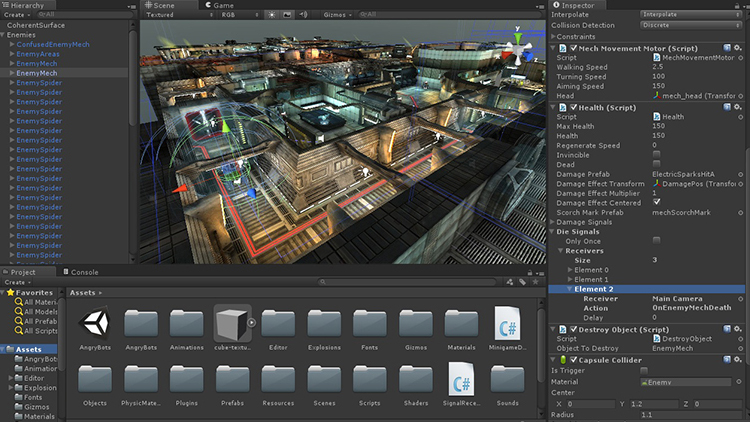Delving into Advanced Unity Features
In this chapter, we’ll delve into more advanced Unity features and explore additional game development tools and resources to broaden your skills and knowledge. We’ll encourage creativity and experimentation with open-ended projects, allowing you to apply what you’ve learned in practical and innovative ways.
Example 1: Advanced Scripting APIs
Explore advanced scripting techniques and APIs in Unity to expand your programming skills and create more complex and dynamic gameplay experiences. Learn about coroutines, delegates, events, and other advanced programming concepts to optimize performance, manage game state, and implement intricate gameplay mechanics.
Example 2: Shaders and Visual Effects
Dive into the world of shaders and visual effects to enhance the aesthetics and immersion of your games. Experiment with shader programming languages like HLSL and ShaderLab to create custom materials, lighting effects, and post-processing effects. Utilize Unity’s Shader Graph tool to create visually stunning and dynamic shaders without writing code.
Example 3: Performance Optimization Techniques
Optimize your game’s performance to ensure smooth and responsive gameplay across different devices and platforms. Learn about performance profiling tools, such as Unity Profiler and Frame Debugger, to identify performance bottlenecks and optimize CPU, GPU, and memory usage. Implement optimization techniques like object pooling, level of detail (LOD), and occlusion culling to improve runtime performance and reduce loading times.
Example 4: Advanced Physics and Simulations
Explore advanced physics simulations and interactions to add depth and realism to your game worlds. Experiment with Unity’s physics engine to create dynamic environments, realistic collisions, and complex interactions between game objects. Implement advanced physics concepts like ragdoll physics, cloth simulations, and vehicle physics to enhance gameplay dynamics and immersion.
Example 5: Networking and Multiplayer
Learn about networking and multiplayer game development to create online multiplayer experiences and connect players from around the world. Explore Unity’s networking solutions, such as UNet (deprecated) or the new Unity Networking system, to implement features like matchmaking, player synchronization, and real-time communication. Build and deploy multiplayer games that support various network architectures, including peer-to-peer and client-server models.
Example 6: Augmented Reality (AR) and Virtual Reality (VR)
Experiment with augmented reality (AR) and virtual reality (VR) technologies to create immersive and interactive experiences that blur the lines between the digital and physical worlds. Utilize Unity’s AR Foundation and XR Interaction Toolkit to develop AR and VR applications for mobile devices, headsets, and other AR/VR platforms. Design and optimize experiences for spatial computing, hand tracking, and immersive audiovisual feedback.
Example 7: Procedural Generation and AI
Harness the power of procedural generation and artificial intelligence (AI) to create dynamic and adaptive game content. Implement procedural generation algorithms to generate randomized levels, terrain, and assets, providing endless replayability and variety for players. Develop AI systems using techniques like finite state machines (FSMs), behavior trees, and machine learning to create lifelike and challenging non-player characters (NPCs) and enemies.
Example 8: Advanced Animation and Rigging
Master advanced animation and rigging techniques to bring your characters and game objects to life with fluid and expressive animations. Learn about Unity’s animation system, including animation blending, inverse kinematics (IK), and root motion, to create cinematic and responsive character animations. Rig complex character models with multiple joints, blend shapes, and constraints to achieve realistic movement and deformation.
Example 9: Visual Scripting and Node-Based Programming
Experiment with visual scripting and node-based programming tools to create gameplay mechanics and systems without writing code. Explore tools like Bolt, Playmaker, and Unreal Engine’s Blueprints to design interactive behaviors, UI interactions, and game logic using visual diagrams and graphs. Iterate quickly and prototype ideas in a visual and intuitive way, empowering designers and artists to create complex interactions and workflows.
Example 10: Open-Ended Projects and Exploration
Encourage creativity and experimentation by embarking on open-ended projects and exploration journeys. Set aside time to work on passion projects, experimental prototypes, or creative exercises that challenge and inspire you. Explore new technologies, genres, and art styles to expand your creative horizons and discover new possibilities in game development.
By delving into these advanced topics and exploring new possibilities in Unity game development, you’ll expand your skill set, push the boundaries of your creativity, and create innovative and memorable experiences that captivate players and leave a lasting impact on the industry. Embrace curiosity, experimentation, and lifelong learning as you continue your journey as a game developer.

Leave a Reply